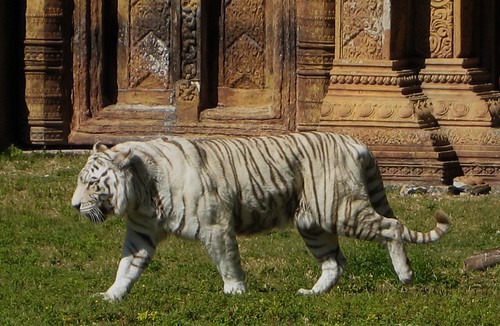White tigers are neither albino, nor do they constitute a separate subspecies and they can breed with orange or brown ones, although approximately half of the resulting offspring will be heterozygous for the recessive white gene and their fur will be orange. But if the orange parent was itself already a heterozygous tiger, which would give each cub a 50 per cent chance of being either double recessive white or heterozygous orange. If two heterozygous tigers or heterozygote breed, on average, 25 per cent of their offspring will be white, 50 per cent will be heterozygous orange (with white genes) and 25 per cent will be homozygous orange (with no white genes).
In the 1970s a pair of heterozygous orange tigers produced 13 cubs in Alipore Zoo, India, out of which 3 were white tiger cubs. If two white tigers breed 100 per cent of their cubs will be homozygous white tigers. A tiger which is homozygous for the white gene may also be heterozygous or homozygous for many different genes. The question whether a tiger is heterozygous (a heterozygote) or homozygous (a homozygote) depends on which gene is being discussed. Inbreeding promotes homozygosis and this fact has been used as a strategy to breed white tigers in captivity.
From the casual way that Jim Corbett makes reference to a white tigress, which he filmed with two orange cubs, in his ‘Man-Eaters of Kumaon’ (1946), it is suggested that white tigers were nothing out of the ordinary to him. Corbett's black and white film footage is probably the only film in existence of a white tiger in the wild. It illustrates again that white tigers survived and reproduced in the wild. The film was used in a National Geographic documentary ‘Man-eaters of India’ (1984), about Corbett's life, based on his 1957 book by the same title.
White tigers with dark stripes were recorded as living in the wild in India during the Mughal Empire (1556-1605). A painting from 1590 of Akbar while hunting near Gwalior depicts four tigers, two of which appear white.
The Journal of The Bombay Natural History Society reported 17 white tigers shot between 1907 and 1933: in several separate locations in Orissa, Bilaspur, Sohagpur and Rewa.
On January 22, 1939, the Prime Minister of Nepal shot a white tiger at Barda camp in Terai, Nepal. The last observed wild white tiger was shot in 1958, and the mutation is believed to be extinct in the wild.
Arthur Locke mentions white tigers in ‘The Tigers Of Trengganu’ (1954).
E.P. Gee collected accounts of 35 white tigers from the wild up to 1959, with still more uncounted from Assam where he had his tea plantation. Some white tigers in the wild had reddish stripes known as ‘red tigers’. The Boga-bagh, or ‘white tiger’, Tea Estate in upper Assam, was named that after two white tigers that were shot there in the early 1900s.
In India, the Rewa hunters' diaries recorded 9 white tigers in the fifty years prior to 1960.
One theory of white tigers holds that they were symptomatic of inbreeding as a consequence of over hunting and habitat loss, as tiger populations became isolated.





